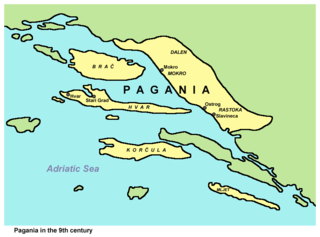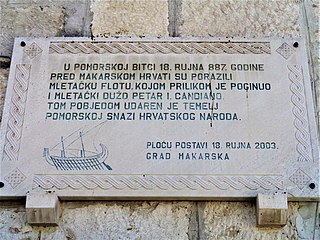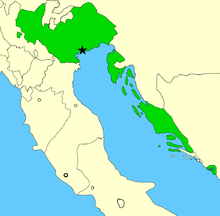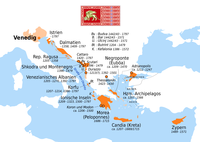
Dalmatia is one of the four historical regions of Croatia, alongside Central Croatia, Slavonia, and Istria, located on the east shore of the Adriatic Sea in Croatia.

Brač is a Croatian island in the Adriatic Sea, with an area of 396 square kilometres (153 sq mi), making it the largest island in Dalmatia, and the third largest in the Adriatic. It is separated from the mainland by the Brač Channel, which is 5 to 13 km wide. The island's tallest peak, Vidova gora, or Mount St. Vid, stands at 780 m (2,560 ft), making it the highest point of the Adriatic islands. The island has a population of 13,931, living in twenty-two settlements, ranging from the main town Supetar, with more than 3,400 inhabitants, to Murvica, where less than two dozen people live. Brač Airport on Brač is the largest airport of all islands surrounding Split.

Zadar, historically known as Zara, is the oldest continuously inhabited city in Croatia. It is situated on the Adriatic Sea, at the northwestern part of Ravni Kotari region. Zadar serves as the seat of Zadar County and of the wider northern Dalmatian region. The city proper covers 25 km2 (9.7 sq mi) with a population of 75,082 in 2011, making it the second-largest city of the region of Dalmatia and the fifth-largest city in the country.

Trogir, historically known as Traù is a historic town and harbour on the Adriatic coast in Split-Dalmatia County, Croatia, with a population of 10,923 (2011) and a total municipal population of 13,192 (2011). The historic city of Trogir is situated on a small island between the Croatian mainland and the island of Čiovo. It lies 27 kilometres west of the city of Split.

Morlachs is an exonym used for a rural Christian community in Herzegovina, Lika and the Dalmatian Hinterland. The term was initially used for a bilingual Vlach pastoralist community in the mountains of Croatia from the second half of the 14th until the early 16th century. Then, when the community straddled the Venetian–Ottoman border until the 17th century, it referred only to the Slavic-speaking people of the Dalmatian Hinterland, Orthodox and Catholic, on both the Venetian and Turkish side. The exonym ceased to be used in an ethnic sense by the end of the 18th century, and came to be viewed as derogatory, but has been renewed as a social or cultural anthropological subject. As the nation-building of the 19th century proceeded, the Vlach/Morlach population residing with the Croats and Serbs of the Dalmatian Hinterland espoused either a Croat or Serb ethnic identity, but preserved some common sociocultural outlines.

The Kingdom of Dalmatia was a crown land of the Austrian Empire (1815–1867) and the Cisleithanian half of Austria-Hungary (1867–1918). It encompassed the entirety of the region of Dalmatia, with its capital at Zadar.
The History of Dalmatia concerns the history of the area that covers eastern coast of the Adriatic Sea and its inland regions, from the 2nd century BC up to the present day. The region was populated by Illyrian tribes around 1,000 B.C, including the Delmatae, who formed a kingdom and for whom the province is named. Later it was conquered by Rome, thus becoming the province of Dalmatia, part of the Roman Empire. Dalmatia was ravaged by barbaric tribes in the beginning of the 4th century.

The Republic of Ragusa was an aristocratic maritime republic centered on the city of Dubrovnik in South Dalmatia that carried that name from 1358 until 1808. It reached its commercial peak in the 15th and the 16th centuries, before being conquered by Napoleon's French Empire and formally annexed by the Napoleonic Kingdom of Italy in 1808. It had a population of about 30,000 people, of whom 5,000 lived within the city walls. Its motto was "Non bene pro toto libertas venditur auro", a Latin phrase which can be translated as "Liberty is not well sold for all the gold".
Paul I Šubić of Bribir was Ban of Croatia between 1275 and 1312, and Lord of Bosnia from 1299 to 1312. As the oldest son of Stephen II of the Šubić noble family, he inherited the title of count of Bribir. He was appointed ban in 1273. He was relieved from duty in 1274, following his involvement in disputes between the Dalmatian coastal cities of Trogir and Split, and was returned to office in 1275.

The Treaty of Zadar, also known as the Treaty of Zara, was a peace treaty signed in Zadar, Dalmatia on February 18, 1358. Under the treaty, the Venetian Republic lost influence over its Dalmatian holdings in exchange for ending hostilities with Louis I of Hungary. Both had been contesting control of a series of territories along the eastern Adriatic coastline in what is now Croatia.

Dalmatian Italians are the historical Italian national minority living in the region of Dalmatia, now part of Croatia and Montenegro.
Croatian art describes the visual arts in Croatia, and art by Croatian artists from prehistoric times to the present. In Early Middle Ages, Croatia was an important centre for art and architecture in south eastern Europe. There were many Croatian artists during the Medieval period, and the arts flourished during the Renaissance. Later styles in Croatia included Baroque and Rococo.

The Stato da Màr or Domini da Mar was the Republic of Venice's maritime and overseas possessions from around 1000 to 1797, including at various times parts of what are now Istria, Dalmatia, Montenegro, Albania, Greece and notably the Ionian Islands, Peloponnese, Crete, Cyclades, Euboea, as well as Cyprus.

Split, historically known as Spalato, is the second-largest city of Croatia, after the capital Zagreb, the largest city in Dalmatia and the largest city on the Croatian coast. It lies on the eastern shore of the Adriatic Sea and is spread over a central peninsula and its surroundings. An intraregional transport hub and popular tourist destination, the city is linked to the Adriatic islands and the Apennine Peninsula. More than 900,000 tourists visit it each year.

The Narentines were a South Slavic tribe noted as pirates on the Adriatic Sea in the 9th and 10th centuries. They occupied an area of southern Dalmatia centered at the river Neretva. Named Narentani in Venetian sources, they were called Paganoi, "pagans", by the Greeks, as they were still pagan after the Christianization of the neighbouring tribes. They were fierce enemies of the Republic of Venice, attacking Venetian merchants and clergy traveling through the Adriatic, and even raiding close to Venice itself and defeating the doge several times. Venetian–Narentine peace treaties did not last long, as the Narentines quickly returned to piracy. They were finally defeated in a Venetian crackdown at the turn of the 10th century and disappeared from sources by the 11th century.

The Theme of Dalmatia was a Byzantine theme on the eastern coast of the Adriatic Sea in Southeastern Europe, headquartered at Jadera.

Dalmatian city-states were formerly Roman municipalities in Dalmatia where the local Romance population survived the Barbarian invasions after the fall of the Western Roman Empire in the 400s CE. Eight little cities were created by the indigenous Illyro-Roman inhabitants of the region, who maintained political links with the Eastern Roman Empire, which in return defended these cities, enabling their commercial trade with Byzantium.
The city of Split was founded as the Greek colony of Aspálathos (Aσπάλαθος) in the 3rd or 2nd century BC. It became a prominent settlement around 650 CE when it succeeded the ancient capital of the Roman province of Dalmatia, Salona. After the Sack of Salona by the Avars and Slavs, the fortified Palace of Diocletian was settled by the Roman refugees. Split became a Byzantine city, to later gradually drift into the sphere of the Republic of Venice and the Kingdom of Croatia, with the Byzantines retaining nominal suzerainty. For much of the High and Late Middle Ages, Split enjoyed autonomy as a free city, caught in the middle of a struggle between Venice and the King of Hungary for control over the Dalmatian city-states.

The Croatian–Venetian wars were a series of periodical, punctuated medieval conflicts and naval campaigns waged for control of the northeastern coast of the Adriatic Sea between the city-state of Venice and the Principality of Croatia, at times allied with neighbouring territories – the Principality of the Narentines and Zahumlje in the south and Istrian peninsula in the north. First struggles occurred at the very beginning of the existence of two conflict parties, they intensified in the 9th century, lessened during the 10th century, but intensified again since the beginning of the 11th century.

The Oltramarini or Schiavoni regiments comprised the overseas infantry of the Republic of Venice. They were a Dalmatian infantry corps organized within the Venetian navy as the elite infantry. They especially stood out in the wars against the Ottoman Empire throughout the Venetian overseas possessions, but also for their service in Terraferma, the Venetian possessions in the hinterland of Venice in northern Italy. In addition, they performed the duties of the bodyguard, first of the provveditore, and later as the personal guard of the Doge himself.




























